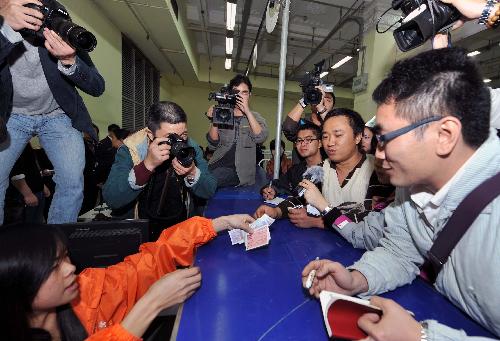Real-name train ticket sale ends
As the Chinese New Year bell struck the zero hour Sunday, a real-name train ticket selling experiment was put an end to in southern China's Guangdong province.
 |
|
Li Jiangang (2nd R), the first passenger with real-name ticket of China, gets his ticket in Guangzhou, capital of south China's Guangdong Province, Jan. 21, 2010. Southern Guangdong Province launched the pilot real-name ticket system Thursday morning amid China's efforts to curb ticket hoarding by scalpers. |
The efforts has turned out to be helpful in allaying travelers' concern for ticket shortages during a travel peak season before the Spring Festival, but failed to uproot scalpers.
In 15 days, the trial operation initiated by China's Ministry of Railways among the stations run by Guangzhou Railway Group has benefited 600,000 travellers who went on their journeys home from Guangdong since Jan. 30 to other inland provinces of Hunan, Sichuan and Guizhou, and Chongqing Municipality.
The nine stations offering such services were all in cities whose economy heavily relies upon migrant workers, including Guangzhou, Shenzhen, Foshan, Dongguan and Huizhou, all in Guangdong Province.
When the trial real-name train ticket selling experiment was on, gone were those long waiting queues -- which had been ubiquitous before the experiment was introduced -- at the entrances of Guangzhou Railway Station where transportation task is usually the heaviest around important traditional Chinese festive seasons such as Spring Festival.
Xiong Xiaoyan, who was heading for her home province of Guizhou, southwest China, was surprised to find the ticket-checking process taking only 10 seconds.
"I thought the waiting line would be much longer than normal as the identity card check was supposed to take more time", she said, "I didn't expect it to be so prompt!"
Huang Xin, director of the passenger transport section of the Guangzhou Railway Group, attributed the efficiency to the improved ticket check-in infrastructure. "We used to have only seven to eight ticket gates. Now the number has grown up to 108," Huang said.
At each entrance gate to the platform, an identity recognition system was put into place. Inspectors could scan a traveller's ticket and his or her ID card separately on two sets of equipment: screens will immediately display the information about a ticket purchaser and the ID card holder with photos. If the names and codes on the ticket and ID card matches, inspectors will stamp the ticket and let go the traveller.
Huang said that this year's pre-Spring Festival single-day traffic record had overtaken that of last year to 232,000 people on Feb. 28.
"I think the pilot operation has successfully passed the ticket check-in test as the extra procedure aiming to secure fairness cut rather than prolong travelers' waiting time," said Huang.
 0
0 






